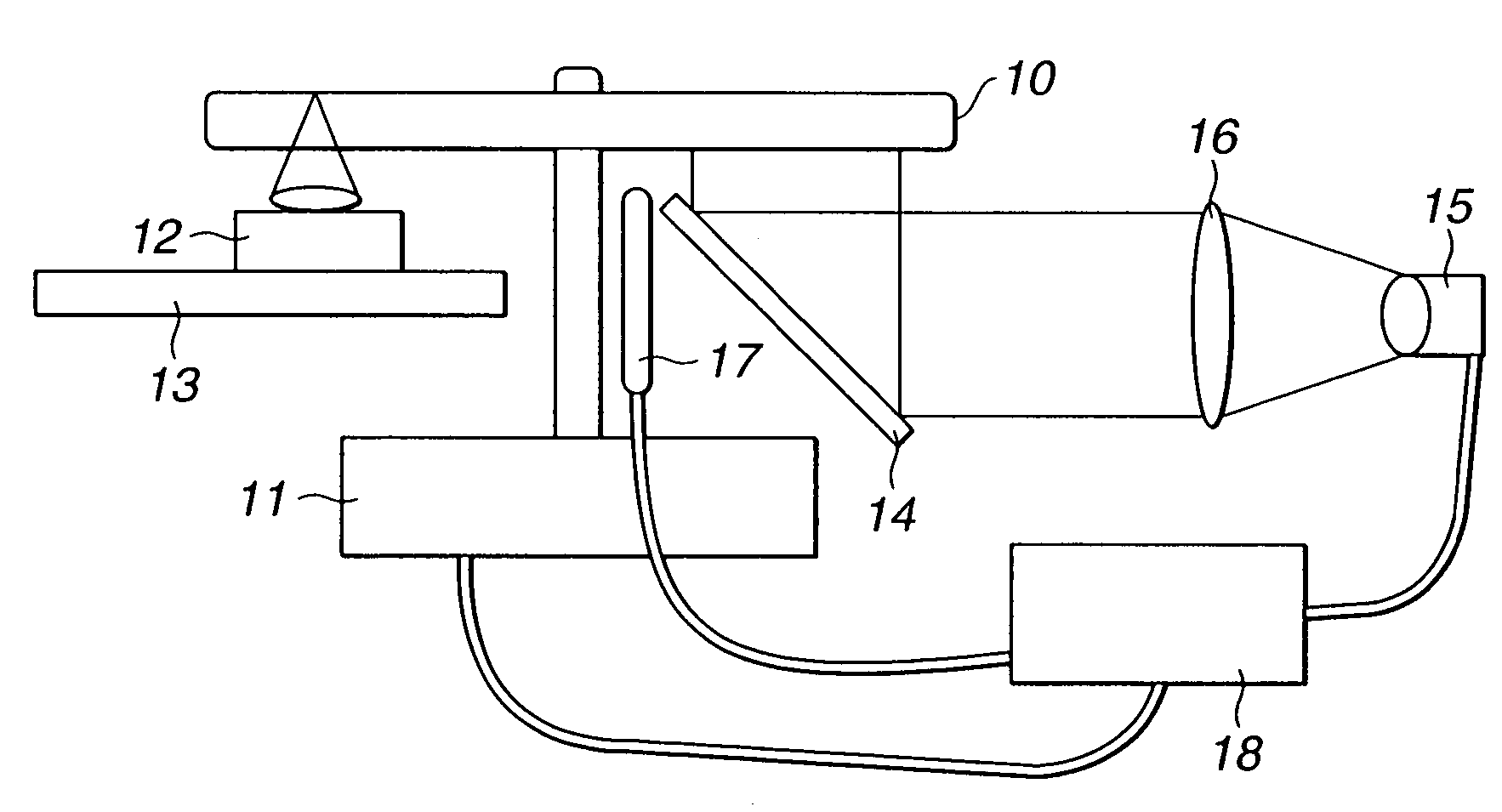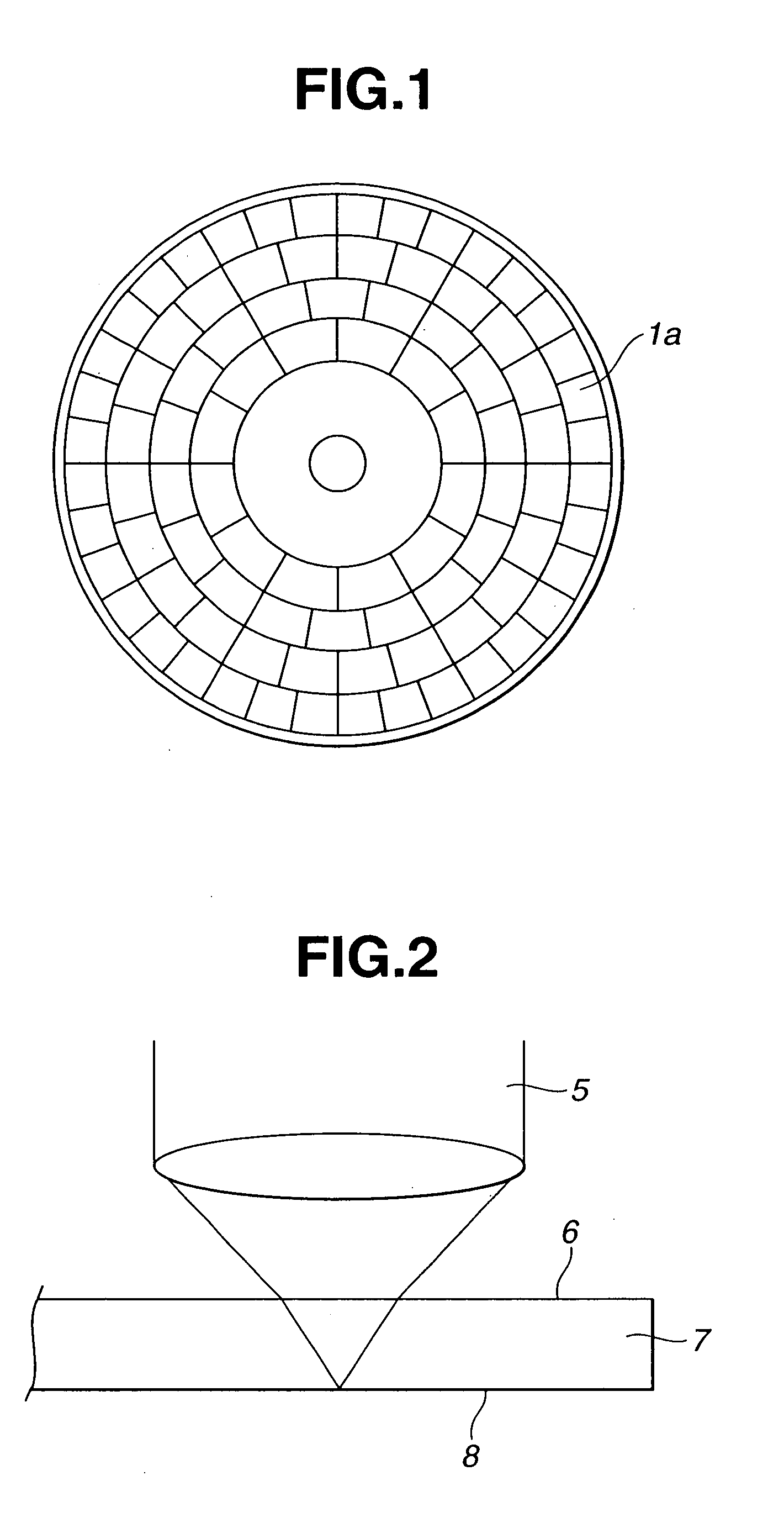Preheating bulk erasing device for magneto-optical disk
a magneto-optical disk and bulk erasing technology, applied in the field of preheating bulk erasing devices for magneto-optical disks, can solve the problems of no practical method and a lot of time, and achieve the effect of reducing tracking errors
- Summary
- Abstract
- Description
- Claims
- Application Information
AI Technical Summary
Benefits of technology
Problems solved by technology
Method used
Image
Examples
embodiment 1
[0056](Embodiment 1)
[0057]First of all, we will explain an embodiment using a magneto-optically recordable / reproducible multi-layer recording film. With a section of the used medium, as shown in FIG. 4, for example, a protective layer 10b-1, a magneto-optical recording layer 10c-1-1, 10c-1-2, 10c-1 -3, a protective layer 10d-1, and a reflective layer 10e-1 are laminated and formed one upon another by a sputtering method on a resin substrate 10a-1 having an address layout in FIG. 1.
[0058]First, a chamber for sputtering each layer was sufficiently evacuated in advance until the reached degree of vacuum is lower than 10−5 Pa. Then, in the atmosphere of 1×10−3 Pa to 6×10−3 Pa, each film was formed by a power of 2–3 kW.
[0059]As the protective layer 10b-1, a silicon nitride film of 80 nm was formed by performing reactive sputtering of a silicon target in the atmosphere of argon and nitrogen.
[0060]As the magneto-optical recording layer 10c-1-1, a film was formed to obtain 40 nm film thickn...
embodiment 2
[0087](Embodiment 2)
[0088]Next, we will explain an embodiment using a magneto-optically recordable / reproducible single-layer recording film. With a section of the used medium, as shown in FIG. 9, for example, a protective layer 10b-2, a magneto-optical recording layer 10c-2, a protective layer 10d-2, and a reflective layer 10e-2 are laminated and formed one upon another by a sputtering method on a resin substrate 10a-2 having an address layout in FIG. 1.
[0089]First, a chamber for sputtering each layer was sufficiently evacuated in advance until the reached degree of vacuum is lower than 10−5 Pa.
[0090]As the protective layer 10b-2, a silicon nitride film of 100 nm was formed by performing reactive sputtering of a silicon target in the atmosphere of argon and nitrogen.
[0091]As the magneto-optical recording layer 10c-2, a film was formed to obtain 50 nm film thickness by performing DC sputtering of a TbFeCo target in the atmosphere of argon. A composition of the target and a condition ...
embodiment 3
[0097](Embodiment 3)
[0098]Next, we will explain an embodiment using a phase-change type recording film. With a section of the used medium, as shown in FIG. 11, for example, a protective layer 10b-3, a phase-change type recording layer 10c-3, a protective layer 10d-3, and a reflective layer 10e-3 are laminated and formed one upon another by a sputtering method on a resin substrate 10a-3 having an address layout in FIG. 1.
[0099]First, a chamber for sputtering each layer is sufficiently evacuated in advance until the reached degree of vacuum is lower than 10−5 Pa.
[0100]As the protective layer 10b-3, a ZnS—SiO2 film of 130 nm was formed by performing sputtering of a ZnS—SiO2 target in the atmosphere of argon.
[0101]As the phase-change type recording layer 10c-3, a film was formed to obtain 15 nm film thickness by performing DC sputtering of a GeSbTe target in the atmosphere of argon. A composition of the target and a condition of film formation were adjusted in advance to have 500° C. cr...
PUM
| Property | Measurement | Unit |
|---|---|---|
| in-surface temperature | aaaaa | aaaaa |
| temperature | aaaaa | aaaaa |
| temperature | aaaaa | aaaaa |
Abstract
Description
Claims
Application Information
 Login to View More
Login to View More - R&D
- Intellectual Property
- Life Sciences
- Materials
- Tech Scout
- Unparalleled Data Quality
- Higher Quality Content
- 60% Fewer Hallucinations
Browse by: Latest US Patents, China's latest patents, Technical Efficacy Thesaurus, Application Domain, Technology Topic, Popular Technical Reports.
© 2025 PatSnap. All rights reserved.Legal|Privacy policy|Modern Slavery Act Transparency Statement|Sitemap|About US| Contact US: help@patsnap.com



